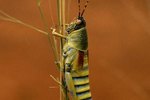
All bats, like their close relatives the primates, have incisors, canines, premolars and molars in their top and bottom jaws. The canines are the set of teeth commonly known as fangs. They are present in all bat species regardless of diet. The shape and texture of the different teeth and the structure of the mouth itself, on the other hand, vary widely depending on the type of food each bat species evolved to eat.
Bugs
Among around 1000 known species of bat, zoologists estimate about 70% eat insects exclusively, and some of the other species occasionally enjoy an insect dinner as well. Insect-eating species catch bugs on the fly. Their incisors and canines do most of the work, snatching and gripping struggling insects and choking them down before they can get away. The fangs of insectivorous bats are very prominent and the front teeth usually take up more space than the premolars and molars.
Fruit
The next largest category of bats is the frugivores. Commonly called fruit bats or flying foxes, these bats subsist mostly on fruit. Contrary to what you might expect, fruit bat fangs are also very prominent and take up a lot of room in the mouth. Fruity fangs serve two purposes: they act like blades to break open hard fruit shells and husks, and they give the bats a wider grip. This wide grip is very important to bats who often harvest and fly away with pieces of fruit larger than their heads. Premolars and molars are more prominent in these species than in non-fruit eaters because they're important for crushing fruit. Some frugivorous bats also have a bony plate on the palate of their upper jaws. They mash the fruit against this plate with their tongues, suck out the juice, and spit out the fibers.
Nectar and Pollen
Some bats feed almost exclusively on nectar and pollen. Their mouth structure is very long and narrow as are their tongues, which are enormous compared to their teeth. Nectarivores' tongues evolved to take over most feeding work, but these bats still have fangs. All of their teeth, however, are extremely small, and their canines aren't very obvious.
Small Animals
A few bat species eat small animals besides insects, preferring small mammals, reptiles and amphibians. Some specialize in catching fish. Like the insectivores, these bats have very prominent, sharp and pointy front teeth. Their premolars and molars vary depending on the type of prey they prefer. Their fangs help them grab, hang onto and fly away with thrashing prey.
Blood
The smallest group of bats, but perhaps the most well-known, is the vampire bats, or sanguivores. There are currently only three known species. These blood eaters do not use their fangs to suck blood. They pierce their prey's skin and lap up their meals with their tongues. Their saliva contains anticoagulants that slow clotting and increase their feeding time. Their mouths are dominated by their small, sharp incisors and canines.
References
- University of Nebraska, Lincoln: Frugivorous and Animalivorous Bats (Microchiroptera) - Dental and Cranial Adaptations
- Mammal Teeth: Origin, Evolution, and Diversity; Peter S. Ungar
- Animal Diversity Web: The Diversity of Cheek Teeth
- University of Nebraska, Lincoln: Form, Function, and Evolution in Skulls and Teeth of Bats
- The Encyclopedia of Earth: Spotted-Winged Fruit Bat
Resources
Photo Credits
-
Anup Shah/Digital Vision/Getty Images
Writer Bio
Angela Libal began writing professionally in 2005. She has published several books, specializing in zoology and animal husbandry. Libal holds a degree in behavioral science: animal science from Moorpark College, a Bachelor of Arts from Sarah Lawrence College and is a graduate student in cryptozoology.



